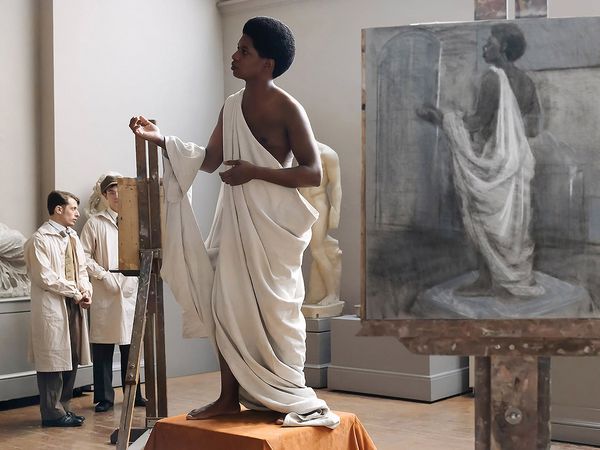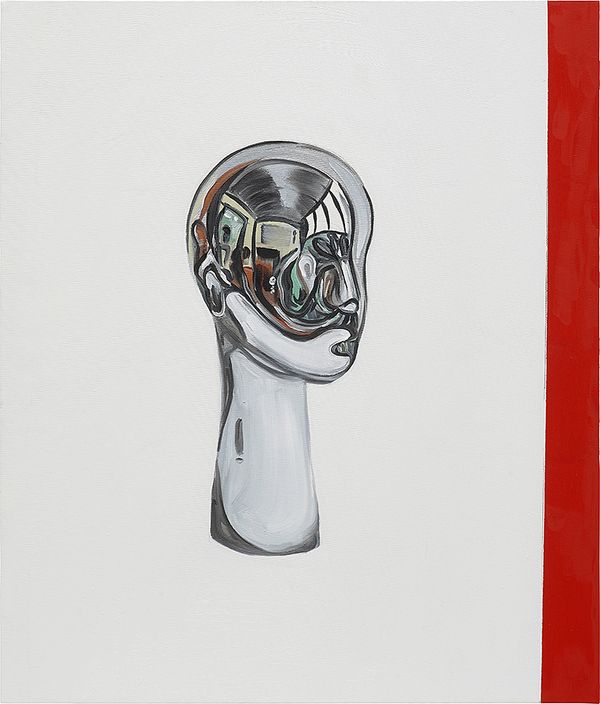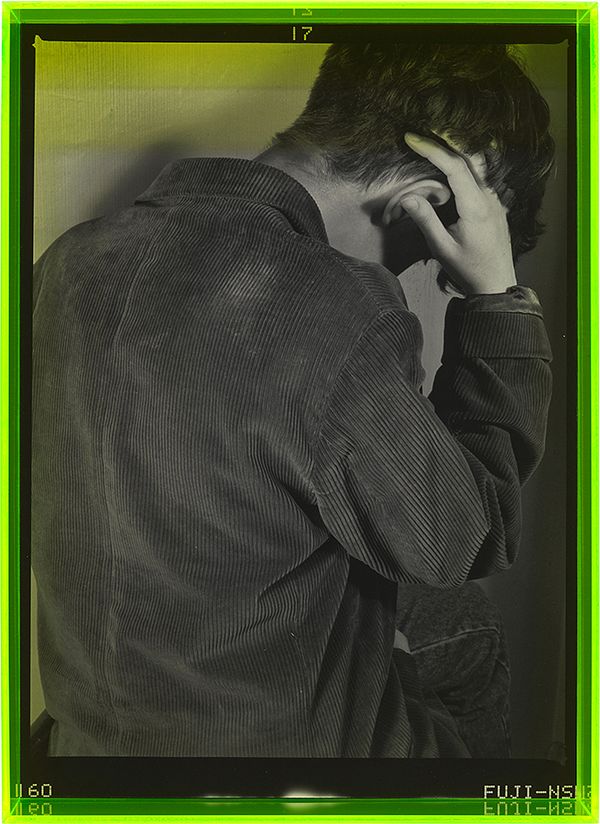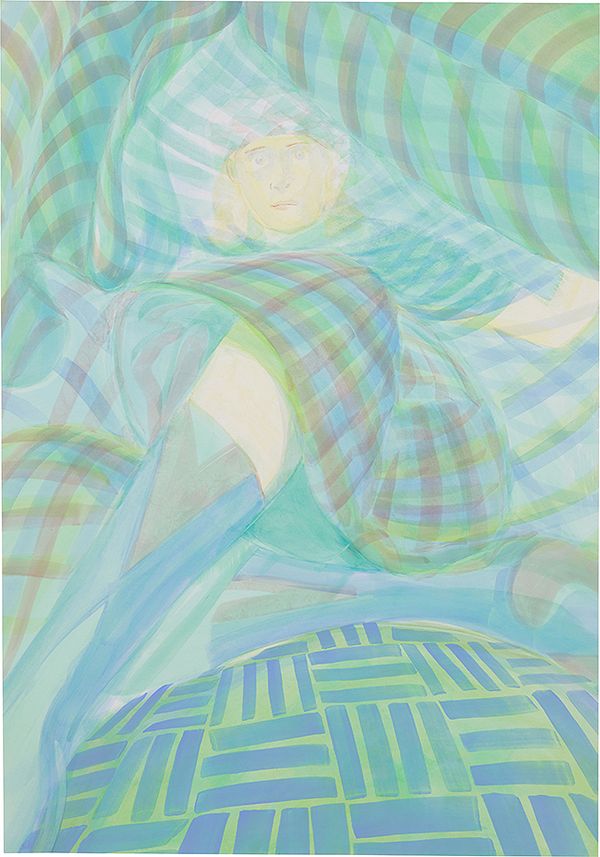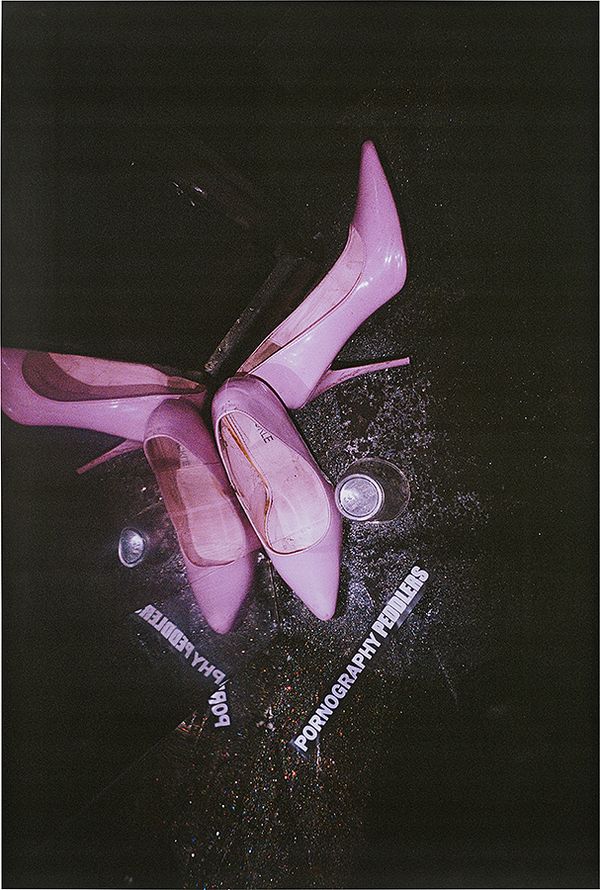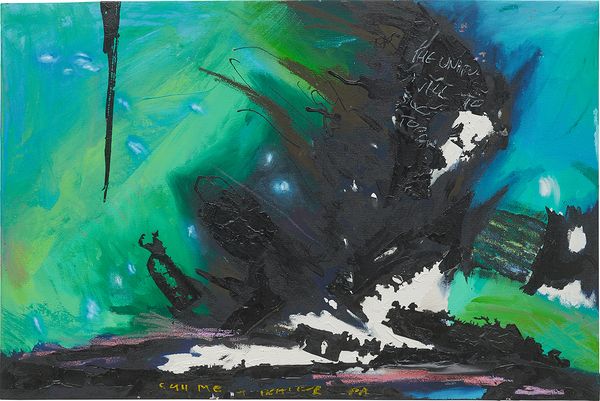Isaac Julien, Black Apollo Diptych (Once Again... Statues Never Die), 2022. Whitechapel Gallery Art Icon: Charity Online Auction.
There’s always a sense of exuberance surrounding the Whitechapel Gallery Art Icon Charity Auction, and why wouldn’t there be? The annual celebration of an icon of contemporary art, alongside fresh works offered in support of Whitechapel’s crucial mission, deserves its place in the cultural calendar. Each year, the uplifting event serves as a reminder that contemporary creativity is absolutely thriving.
Phillips is proud to partner with the gallery once again for the 2024 Whitechapel Gallery Art Icon: Charity Online Auction. This year’s iconic honoree is Isaac Julien, the pioneering British artist whose lauded practice has broken barriers between artistic disciplines. His work throughout his trailblazing career has paved the way for the next generation of artists also on offer in the auction.
Ahead of the auction, we caught up with six of the artists who have donated works to this year’s auction to hear about their works in the sale, what inspires them, and how they approach making art in 2024.
The Whitechapel Gallery Art Icon: Charity Online Auction is open for bidding 12–19 March.
Kate Groobey
Kate Groobey, Higher II, 2023. Whitechapel Gallery Art Icon: Charity Online Auction.
PHILLIPS: Tell us about the work you’ve donated to this year’s Whitechapel Gallery Art Icon Charity Auction.
KATE GROOBEY: Higher II is part of my new painting and performance series, called Always Love, which asks what we can do in personally and politically heart-breaking times, and finds the answer is always love. Higher II speaks about the importance of the basic need people have to feel supported and safe in their environments. The rose is the symbolic pick-me-up we all sometimes need at home, at work, from wider society, our institutions and state apparatus, and from beyond our national borders.
P: How does the work relate to the rest of your oeuvre? What is its special significance for you?
KG: Like all my work, the protagonists in Higher are me, as my alter ego the “female stallion” and my wife, the writer and poet Jina Khayyer. What is special about Higher is it’s one of two images in my Always Love series where a third protagonist appears. I think of this character as an extra place in the painting for the viewer to join us and enter into the narrative in order to practice empathy and solidarity, practices I believe are essential for a healthy society. Also special, it’s painted on a new small scale that replicates the intimacy of my preparatory drawings and watercolors and the stories being told.
P: How do you see your practice in relation to the broader cultural landscape right now?
KG: The story of art is being rewritten and diversified by artists. There are some great lesbian figurative painters now addressing the real need to assert the presence of queer womanhood into the tradition of figurative painting — think Jenna Gribbon or Ana Benaroya. Like them, I am portraying powerful queer females and their subjectivity. We’ve been aware of queer male subjectivity in figurative painting since Francis Bacon and David Hockney, and it’s so exciting to see a completely new perspective in the field of painting being retold by female painters of my generation.
P: Are there any movies, songs, books, or trends that inspire you or influence your work at the moment?
KG: My wife’s poetry and way of looking at the world is a constant source in my paintings. I often reach for my notepad when we’re talking. Always Love is built around our desires, philosophy, and poetry. It’s me speaking to all the things we’ve seen, experienced, and talked about everyday this last year and a half.
P: Describe a particularly meaningful or memorable highlight of your career thus far.
KG: One show that really helped me crystallize what kind of feelings I want my exhibitions to give rise to was Pure Pleasure, which was shown at the Ikon Gallery in Birmingham in 2018. I had a lot of response from the public, who sent me messages on Instagram saying how inspiring the show was, and how good it made them feel. That was quite special for me — that show I had made could really inspire people. Since then, I’ve wanted to create beautiful, safe, feminine, and queer spaces, which could inspire others and make people feel a bit stronger or a bit more empowered.
P: What does Whitechapel Gallery mean to you? Have any Whitechapel exhibitions resonated with you and your own work?
KG: Many exhibitions have resonated with me, but I think what they all give voice to is a kind of integrity that I associate with the Whitechapel Gallery. It’s the kind of institution that supports new ways of seeing and thinking.
Gaby Sahhar
Gaby Sahhar, Memory of a Journey, 2024. Whitechapel Gallery Art Icon: Charity Online Auction.
PHILLIPS: Tell us about the work you’ve donated to this year’s Whitechapel Gallery Art Icon Charity Auction.
GABY SAHHAR: The work Memory of a Journey is a small painting of a reflective mannequin head that reflects a view of an urban flat share in London. I was inspired by the Cologne Situationist movement from the early 20th century that dealt with the experience of alienation due to capitalist modes of production. They often would leave faces black when representing figurative forms. I felt like there was a lot of crossover between that movement and the current cost of living crises in London, especially surrounding property. I wanted to capture the experience and raise awareness of who is affected the most, while simultaneously painting an environment that was questioning the experiences of stability, movement, and migration within cities.
P: How does the work relate to the rest of your oeuvre? What is its special significance for you?
GS: I’ve always been interested in pushing new ways of representing the figurative form in my work. Being part of the LGBTQIA+ community and having French Palestinian heritage in the UK has forced me from a young age to think internationally and in terms of intersectionality about my experiences and work. I had the privilege of being part of a lot of sub-communities in the city growing up. All of this has pushed my art practice into become a type of third space for self-expression and world building. This usually takes the form of paintings, film, and installation.
P: How do you see your practice in relation to the broader cultural landscape right now?
GS: When I think of broader culture, I think about how the political system in this country continues to change and shift in a right-wing direction. This unfortunately results in a higher degree of censorship and inequality, and a rise in anti-immigration laws and hate crimes. This is felt through every industry but strongly within the arts and wider cultural sectors. The result of this growing culture of fear is we end up not being able to speak about issues such as Palestine. An issue that is very close to me and my work now. It means culture shifts back into the underground and becomes a subculture again. This is something I am trying to address and reverse with my work.
P: Are there any movies, songs, books, or trends that inspire you or influence your work at the moment?
GS: I’ve been inspired by a lot of literature and films that tackle issues of migration between European borders to the Arab world at the moment: contemporary Arab writers such as Abdellah Taïa, Leïla Slimani and Adania Shibli, and films such as The Edge of Heaven by Faith Akin and Return to Seoul by Davy Chou. I also find Octavia E. Butler, Judith Butler, Edward Said, and James Baldwin to be constant sources of inspiration. I’ve been more broadly inspired by the pro-Palestinian protests in London and the colors of the flags that dominate the skyline in Tower Hamlets, London where I am currently living.
P: Describe a particularly meaningful or memorable highlight of your career thus far.
GS: I see every moment in my career as a highlight, but I would say a few of them have included creating the biggest painting I have ever made. The work was seven meters long and stretched on a circular metal frame, with a film inside. This was shown in Paris at Mac Val in 2023 and funded by a French art award I won. I was really happy to be invited to curate an exhibition at The Shop — Sadie Coles’ HQ. This was a collaboration with Queerdirect, an LGBTQIA+ artist network I run. The show had a great reception with a performance that shut down Soho. I am also super excited to be part of a group exhibition at the Institut du Monde Arabe in Paris that opens in April this year.
P: What does Whitechapel Gallery mean to you? Have any Whitechapel exhibitions resonated with you and your own work?
GS: The gallery means a lot to me in many ways. It’s now my local gallery and it keeps entering my life at different stages of my career. I used to be part of the youth group Duchamp and Sons when I was a crazy teenager. In 2022, I was invited to curate a show with the collective that would be on display in the upstairs gallery which was a surprise. It felt like history repeating itself from my youth, but I loved it. The show we created was titled Escape the Slick and examined the relationship between public and private space in the local area. This resulted in an immersive experimental installation that collapsed different scenes of the local geography and challenges the role of the institution.
Jyll Bradley
Jyll Bradley, Self Portrait 1987–2023, 2024. Whitechapel Gallery Art Icon: Charity Online Auction.
PHILLIPS: Tell us about the work you’ve donated to this year’s Whitechapel Gallery Art Icon Charity Auction.
JYLL BRADLEY: I’m donating Self Portrait, 1987–2023. It’s a hitherto unseen photographic self-portrait I took in my bedroom in the late 1980s. I’ve created a bespoke frame for the work, so it has a sculptural quality. The image is very personal, speaking to my desire then as a young queer woman to be seen and understood, but also hide out and be private. So, I am turning away from the camera and into abstraction as a way of expressing the strangeness of my experience. Now, 35 years later, I’m re-visiting and honoring this image, framing it with a fluorescent, celebratory material from my adult life.
P: How does the work relate to the rest of your oeuvre? What is its special significance for you?
JB: I’m interested in the idea of “queering Minimalism” — of how formal, simple structures can create a space for exploring ideas of identity and place. The work also reflects a creative process I’m going through which I’d describe as “running and returning.” This involves exploring my archive — where I found this photograph — not just to look at what I made years ago, but to make new things from what I discover. As artists we are running, propelled forward by creative energy, yet we are always returning to an essence of who we are.
P: How do you see your practice in relation to the broader cultural landscape right now?
JB: For me, the power of joy should never be underestimated, even and perhaps especially in the very difficult times we live in. Hard won joy is something I sense and identify with across the current art landscape regarding older women artists having their moment. I feel creatively energized by recent shows such as Ingrid Pollard’s Carbon Slowly Turning and Zineb Sedira’s Dreams Have No Titles. They demonstrate complex weavings together of the personal and political. I left both shows with a rich feeling of lives well lived through creativity, and a challenge to be a better version of myself. For me, this is the healing potential of art.
P: Are there any movies, songs, books, or trends that inspire you or influence your work at the moment?
JB: I’m interested in the place where practical and spiritual realms meet. Every morning my partner and I study a page together of The Tanya, a hugely inspiring 18th century Jewish handbook on how to live. I love memoirs where artists reflect on creative identity — I’ve recently enjoyed writer Bernardine Evaristo’s Manifesto: On Never Giving Up and music producer Rick Rubin’s The Creative Act: A Way of Being. I’m now immersed in the genre-defying beauty of Noreen Masud’s A Flat Place. I avidly follow the music of Anna Clyne and Linda Buckley, two fantastic composers with whom I've collaborated on recent film projects.
P: Describe a particularly meaningful or memorable highlight of your career thus far.
JB: Creating the sculptural installation Green/Light (for M.R.), 2014 for The Folkestone Triennial was very meaningful. I was born and adopted in Folkestone under difficult circumstances, so I had mixed feelings towards the town. Green/Light drew together a structure from my rural childhood — a hop garden — and the urban materiality of my adult life, thus uniting disparate aspects of self. It was a work of personal and artistic reconciliation and became a catalyst for local regeneration. I am every grateful to Triennial Curator Lewis Biggs who took a huge leap of faith in me: he commissioned Green/Light, my first “built” sculpture.
P: What does Whitechapel Gallery mean to you? Have any Whitechapel exhibitions resonated with you and your own work?
JB: Most London galleries are in the polished “west”. What makes the Whitechapel meaningful to me is its historic “east” location within the heartlands of diverse populations and creative communities. For this reason, I think of the Whitechapel as the “artists” gallery. A formative moment there was in 1988 seeing a dance work titled Man, Melon, Moon performed by the wonderful artist and teacher David Ward. Remembering this, a few years ago I invited David to perform in one of my sculptures. This then evolved into a film. The Whitechapel as mothership of artist collaboration and inter-generational influence cycles on.
Hannah Tilson
Hannah Tilson, The City Speaks To Her, 2023. Whitechapel Gallery Art Icon: Charity Online Auction.
PHILLIPS: Tell us about the work you’ve donated to this year’s Whitechapel Gallery Art Icon Charity Auction.
HANNAH TILSON: In The City Speaks to Her something monumental is being pushed to the boundary of the picture plane. Veils of luminous, translucent, raw powder pigments are built up allowing the work to breathe and emit light. A figure is encompassed in a fast-moving “patternscape” — a kinetic landscape made of patterns. Disappearing and re-emerging, sometimes completely swallowed up by fabric, at other times a face surfaces and pulls the viewer closer to reality. The continuous rolling façade of the city never stops folding, pleating, shifting. An obscuring skin distorting our surroundings. Body and building morph together. The figure camouflages and circumvolves into the surface. Brushstrokes vibrate and hum rhythmically together.
P: How does the work relate to the rest of your oeuvre? What is its special significance for you?
HT: Over the last seven years, I have been creating and exploring four patterned worlds. This painting and the works I make in my studio are windows and portals into these patterned dimensions: The draped, theatrical stages I set up in my bedroom, dress up in, film myself moving around, and then paint self-portraits from; the humming crisscross-patterned tiled floor I installed in my solo exhibition Swoosh in Margate; the suits I paint on, wear and perform in around the city; and the fragmented architectural checkered world I designed on sketch-up and painted from while I was studying at the Slade.
P: How do you see your practice in relation to the broader cultural landscape right now?
HT: Living and working within a city and being immersed in the freneticism of everyday life largely influences my work. I create illusionary spaces — image planes become jigsaw shapes and interchangeable parts of layered patterned worlds for people to lose themselves in. During a time when everything can be so immediately accessed, our attention spans dwindle and it’s hard to find space to zone in on things. Information speeds at us through our screens, becoming a ball of energy, a frenzy of online algorithms. The faces and figures in my work often don’t appear at first glance. They emerge when you slow down and look twice.
P: Are there any movies, songs, books, or trends that inspire you or influence your work at the moment?
HT: My day is curated through music. I am a trombonist and singer as well as a painter. Beyonce, Ryuichi Sakamoto, Gwen Stefani, Verdi, Black Eyed Peas, Glen Miller, Doja Cat, and Janet Jackson fill my day like a film score. Carrying me softly through the morning and feeding me with energy during my pose lunch lull.
I’m a fan of Rudolf Laban, a Hungarian dancer and movement theorist who developed the Laban motion technique, which categorizes movement into four components: direction, weight, speed, and flow. I apply these gestures and rhythms to my body while I work. It allows for fresh and unexpected moments to happen in my paintings.
P: Describe a particularly meaningful or memorable highlight of your career thus far.
HT: In 2023 I taught a patterns and printmaking course at the Salzburg Summer Academy, founded by Oskar Kokoschka. Artists like Bridget Riley have taught there. It’s a surreal and energizing experience working in a fortress surrounded by such rich history. Prior to this, I hadn’t incorporated my printmaking into paintings.
Straight after Salzburg, I undertook a residency at Palazzo Monti in Brescia. When I returned to my studio all my ideas and the excitement from these trips came out in a burst of energy. My friend recently spoke of a Derek Walcott line in a poem written about Peter Doig: “Will your brush pick up an accent.” I like this idea of places you work in and travel carrying accents and new influences with them.
P: What does Whitechapel Gallery mean to you? Have any Whitechapel exhibitions resonated with you and your own work?
HT: I have been visiting the gallery throughout my life and recognize not everyone has early exposure to exhibitions. I admire that Whitechapel Gallery addresses this gap by running workshops to engage children in the art world from a young age, as well as community programs that ensure art is accessible to a diverse range of individuals.
I loved the Nicole Eisenman exhibition. Her paintings left me wanting to immediately teleport myself or run to my studio. Her works are effortlessly fearless and inspiring. She works powerfully across so many mediums, paving the way and showing artists that if you dare, anything is possible.
Rene Matić
Rene Matić, Pink Shoes at a Party, 2023. Whitechapel Gallery Art Icon: Charity Online Auction.
PHILLIPS: Tell us about the work you’ve donated to this year’s Whitechapel Gallery Art Icon Charity Auction.
Rene Matić: The photograph was taken at a birthday party in February 2023 — themed for the television drama The L Word — in a basement of some pub somewhere in Euston where I danced until 3am.
P: How does the work relate to the rest of your oeuvre? What is its special significance for you?
RM: The space in which this photo was taken both physically and metaphorically is a space I work and live form. It is a space of intimacy. Often, it is where I begin, and also where I end up.
P: Are there any movies, songs, books, or trends that inspire you or influence your work at the moment?
RM: Music leads a lot of what I do. It can range from Reggae/Ska/Northern Sould and Jazz to Lady Gaga and Ice Spice. Right now, I’m listening to a lot of Abba. Dancing Queen is on repeat.
P: Describe a particularly meaningful or memorable highlight of your career thus far.
RM: My Show Upon This Rock at South London Gallery in 2022 was incredibly special because of how personal and delicate it was not just for me but for my family. That show took a look and gave a lot, the main work was a film piece that was in one sense a portrait of my father, but a portrait made through my family as a whole. I currently have a show with Oscar Murillo at Kunsthalle Wien. Finding a rhythm with another artist in this way has been wonderful.
PHILLIPS: Tell us about the work you’ve donated to this year’s Whitechapel Gallery Art Icon Charity Auction.
Jerome: My donation is a new work called People Who Believe. The title comes from observing how the materials in the work interact and build upon the overall concept of expressing life through painting. The materiality reveals various forms of resistance and renewal, from the oil pastels resisting the ink to the metamorphosis of peeled dried paint into the final compositions. Whether through self-assurance or belief in a divine force, I think the work highlights through painting a playful conviction that no matter what we will continue to love, laugh, and live.
P: How does the work relate to the rest of your oeuvre? What is its special significance for you?
J: This work relates to a wider five-year ongoing body of work called Action Black, some of which I exhibited last year at both the Whitechapel Gallery and Niru Ratnam Gallery. Viewers are presented with a contemporary position that engages with the histories of abstract painting, performance, installation, and audience participation.
The works add to conversations already present in abstract painting art histories through challenging established ideas. Verticality as a metaphor for life, black paint in relation to light, and the use of color and form as a means of moving the work beyond aesthetic propositions. People who Believe is the latest and most exciting exploration into these conversations.
P: How do you see your practice in relation to the broader cultural landscape right now?
J: My practice uses the relationships between different mediums to explore conversations around the ambiguity of identity and life.
I often work on several pieces simultaneously that can connect, disconnect, and reconnect at different stages. This multi-layered concurrent way of working feels natural to me, and I have come to think of it as a metaphor, not only for the multifaceted interests’ subjectivities that inform my thinking, but a representation of the layered and interconnected post-internet culture we inhabit.
Graduating from the Royal College of Art Painting course in 2019 and working as a Senior Lecturer in Painting at Camberwell since 2021, it feels like an increased number of artists are working this way.
P: Are there any movies, songs, books, or trends that inspire you or influence your work at the moment?
J: The TV series Atlanta — specifically season four — I think is an example of an artist trusting in their knowledge of their medium and allowing their creativity to guide them irrespective of promoted traditions.
My music tastes are varied and change from day to day. I think Cleo Sol’s “Go Baby” and Nali’s “4 U” represent the frequency I would like to engage with daily. However, I regularly listen to Harlem Spartans as well.
P: What does Whitechapel Gallery mean to you? Have any Whitechapel exhibitions resonated with you and your own work?
J: I exhibited in the Life is More Important than Art show at Whitechapel Gallery in 2023 which I would say is the memorable highlight of my career so far. Like many artists the Whitechapel Gallery is a space I associate with inspiring artists and their work, so it was great to be able to add to that history.
During the exhibition I got to meet and exhibit alongside John Smith, an artist I studied at school, as well as other reputable artists’ works I respect and admire such as Janette Parris and Osman Yousefzada. Thematically the show couldn’t have been better suited for me. The Action Black series has been exploring ways in which I can input lived experience into paintings and the show was about the intersections between life and art.
The Whitechapel Gallery is an incredibly important institution that during its inception prioritized a connection to its local community and artists. I know that there is a refocus back towards the gallery’s original priorities under the new director Gilane Tawadros, and I think that she is leading a change that is already being felt by artists like myself.
Discover More from 20th Century & Contemporary Art >
Recommended Reading
Auction Debuts: Now Arriving in New York >
Painter’s Choice: Behind the Process >
